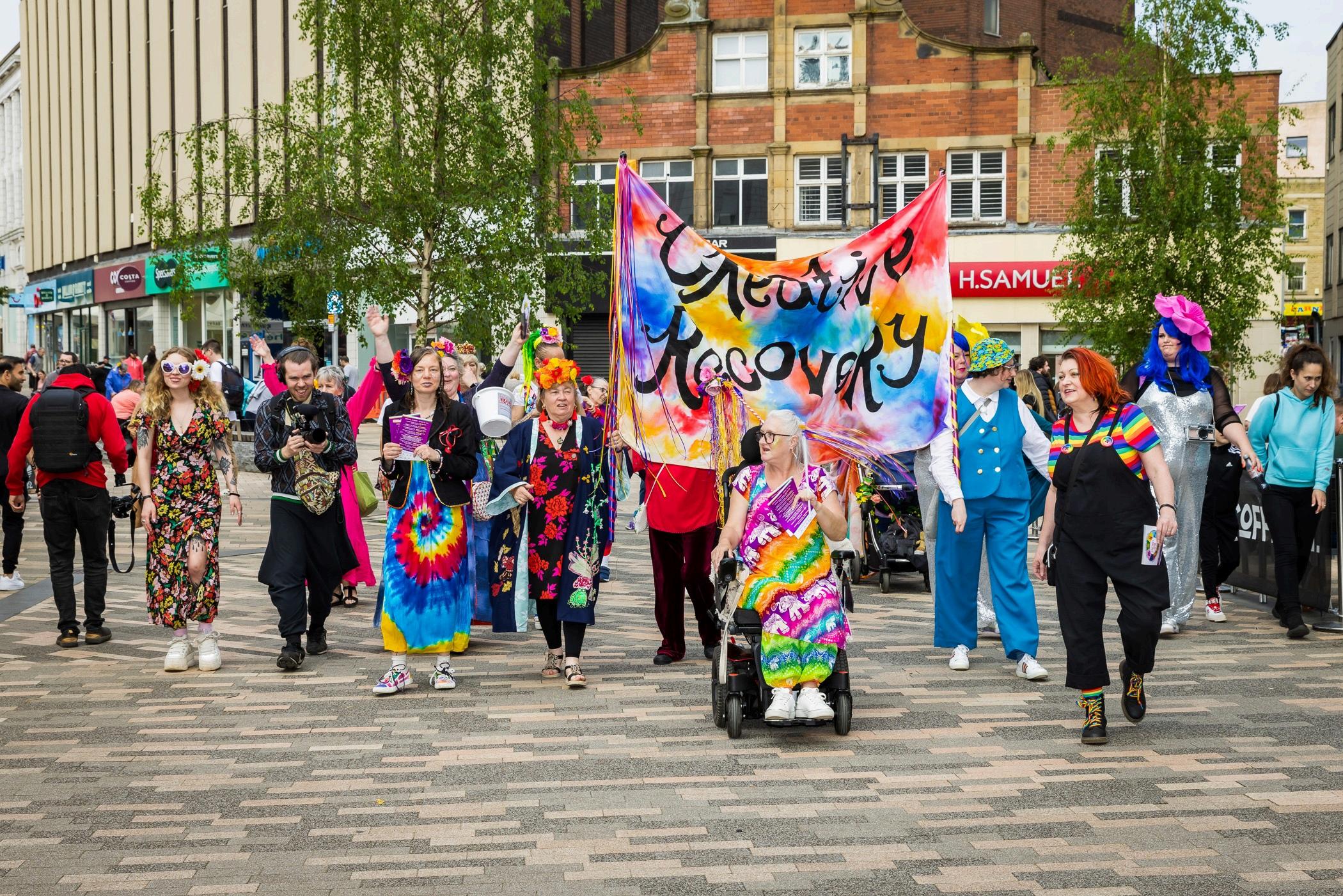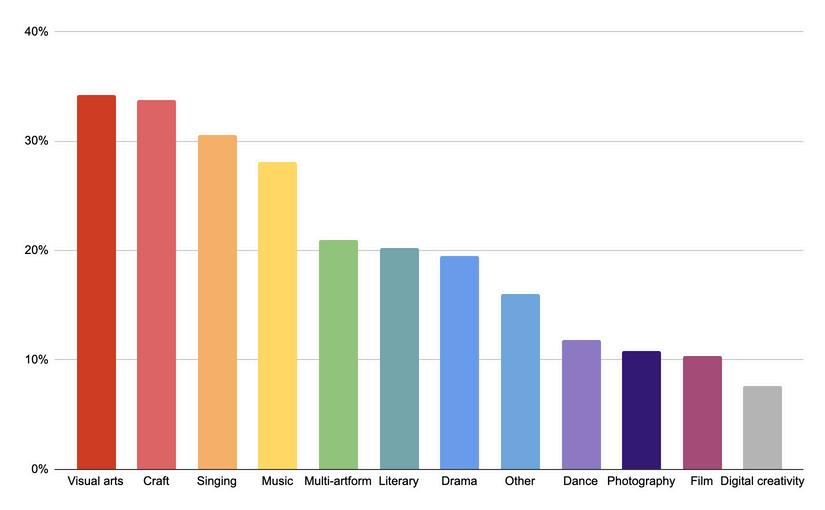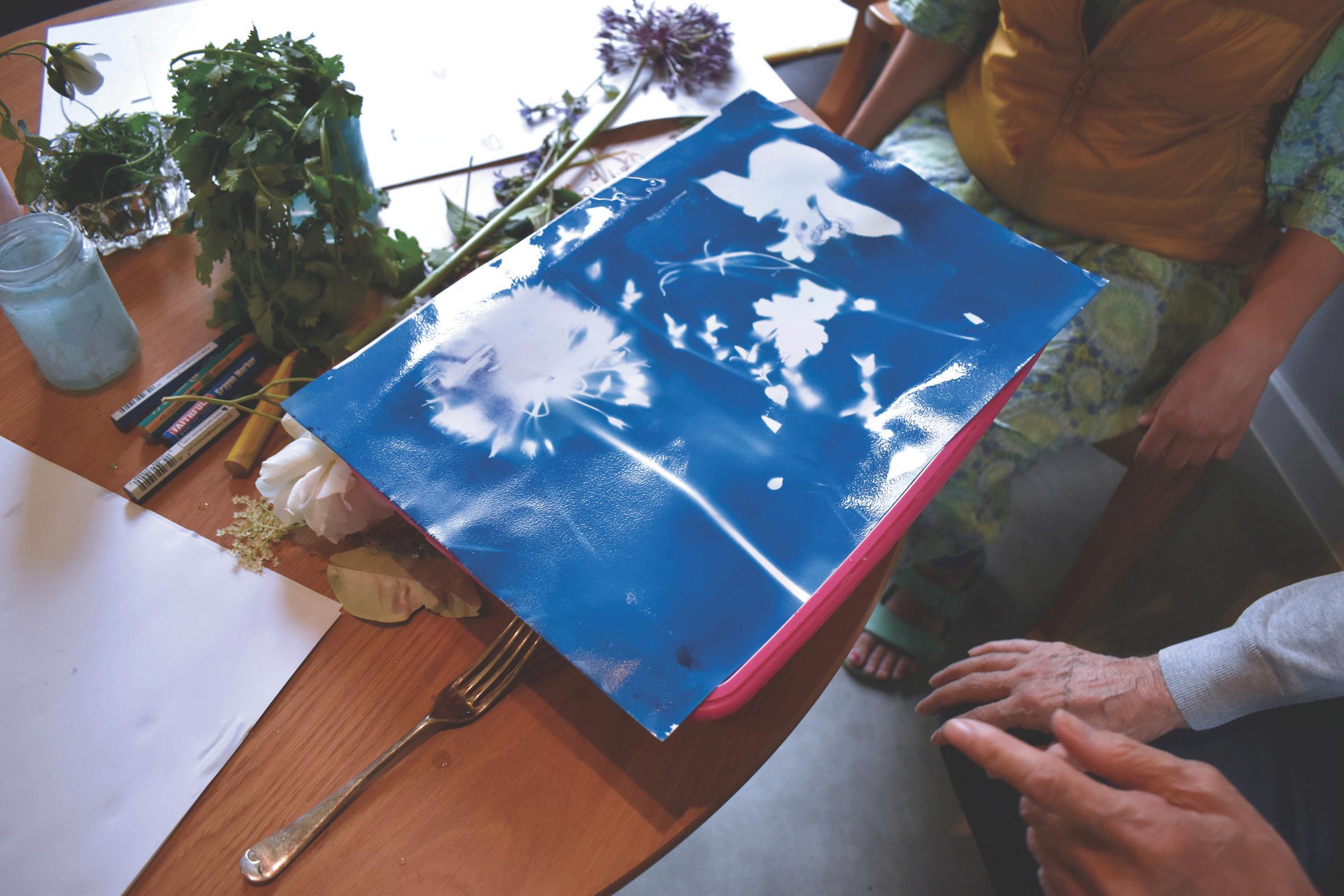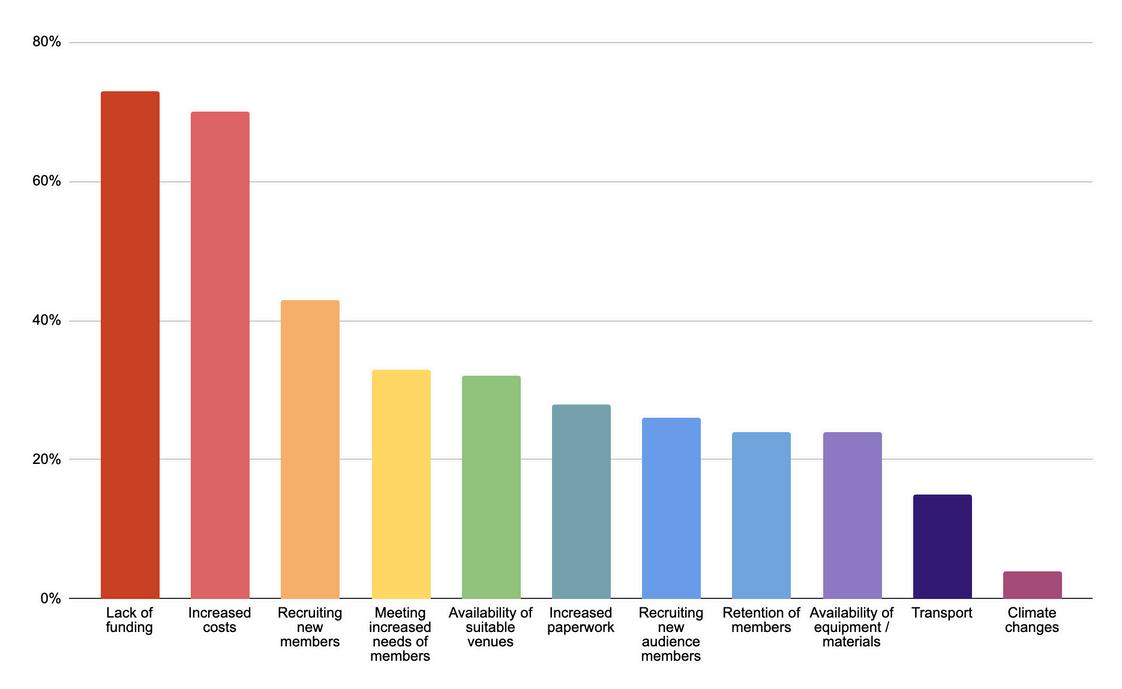






June 2025
The Creative Lives Monitor 2025 is a survey conducted by Creative Lives into the health of local creative groups across the UK and Ireland.
The survey takes a quantitative approach to measure the capacity, resilience, and connections of these groups, using a 1 to 5 scale (1 negative, 5 positive).
Overall, we calculated an average score of 3.08 for the health of local creative groups. This score indicates that, on average, groups are just above surviving. The highest average score was for optimism about the future (3.76), although this is down significantly from previous survey years. The second highest score was for sufficient members (3.67), suggesting groups generally have enough participants - although groups are experiencing difficulties with capacity, high turnover, and attracting younger members.
Key challenges identified include insufficient volunteers (average 3.16), with many groups reliant on a small core team facing recruitment and retention issues. Funding and resources were the lowest scoring areas (average 2.67 for resources; 2.72 for audience members), revealing a desperately underresourced sector. Groups struggle with difficulty accessing funding, rising costs, venue issues, staffing costs, and unreliable income streams. Relying on audience income for sustainability is also challenging due to affordability, fluctuating attendance, and high costs.
There is a notable institutional disconnection, with groups feeling least connected to Local Authorities (average 2.34). Confidence in raising concerns with Local Authorities is also low (average 2.64).
The most frequently mentioned change needed for groups to thrive is funding, specifically core funding for running costs rather than just project-based support. Access to suitable and affordable venues, increased membership and volunteer support, and administrative or expert support are also critical needs.
In conclusion, we found a resilient but strained sector facing systemic challenges such as structural funding issues, volunteer burnout, institutional isolation, an aging demographic, and the impact of the cost of living crisis. Addressing these issues could significantly strengthen this vital sector, which provides crucial social and cultural infrastructure, and brings huge benefit to individual and community wellbeing.
The overall picture of the health of local creative groups Positive
We asked local creative groups questions about their capacity, their resilience, and their connections All answers were rated on a sliding scale from 1 (negative) to 5 (positive). The chart below shows the average scores for each question across the survey.
3.08 Average score across all measures
3.76 Optimism about the future of group or activity
3.67 Sufficient members
3.41 Change in the state of group or activity
3.40 The current state of group or activity
3.27 The range of creative opportunities in an area
3.16 Sufficient volunteers
3.15
2.74
Connections to other local creative groups
Connections to the wider arts and cultural sector
2.72 Sufficient audience members
2.67 Sufficient resources
2.64
2.34
Confidence in raising concerns with Local Authority
Connections to the Local Authority
Since 2017, Creative Lives has been running the Big Conversation, our biennial survey about participation in voluntary-led creative groups across the UK and Ireland.
As part of our new Strategic Plan for 2024-29, we have changed our approach to attempt to monitor the relative health of the local creative sector.
Our aim was to take a more quantitative approach: to attempt to put figures on the current capacity of local creative groups, their resilience, and the strength of their local connections. This, we hoped, would enable us to establish overall figures for these metrics; track changes year on year; and compare the relative health of local areas with a national picture.
We have retained some questions from our previous surveys, e.g. ‘How optimistic do you feel about the future of your group or activity?’, as well as questions about the usefulness of Creative Lives’ support, to enable comparison with earlier responses.
This report presents the findings from our research and considers the implications.
It goes without saying that each creative group is unique, working within its own set of circumstances, and this report doesn’t fully reflect the experience of every group. It is clear that some groups are thriving while some groups are on the verge of permanent closure. We are incredibly grateful to everyone who completed the survey and wrote such thoughtful responses. We hope that this overview is seen as indicative of the broad range of issues facing local creative groups, while recognising that individual experiences may differ from this picture.

The purpose of the survey was to explore the relative health of local creative groups across the UK and Ireland.
In total, we received 407 responses. The survey was aimed particularly at local creative groups - in contrast to our previous surveys (The Big Conversation) which sought views from the wider creative sector, as well as individuals who weren’t creatively active. The survey was shared in our monthly e-newsletter, on our social media channels, and promoted through various partner organisations. We offered an incentive of a micro-grant (£250 / €300) to one group drawn at random from the completed entries, when the survey closed.
Respondents were involved in a diverse range of artforms, with a large overlap from groups involved in multi-artforms, and we therefore feel that the findings are broadly representative of the voluntary creative sector.


On a scale of 1 to 5, how would you describe the current state of your creative group or activity? (From 1 ‘Struggling’ to 5 ‘Thriving’)
Average score: 3.40
Since January 2024, how has the state of your group or activity changed? (From 1 ‘Worsened’ to 5 ‘Improved’)
Average score: 3.41
A rating above 3 would indicate that, on average, local creative groups are just above surviving, and that their position had improved slightly from the year before.
Does your group have sufficient members (people regularly taking part in the creative activity) to be sustainable for the next few years? (From 1 ‘Not at all’ to 5 ‘Plenty’)
Average score: 3.67
Overall, the position is very encouraging: groups have enough participants, with many groups stating that they are oversubscribed with waiting lists. At 3.67, the response was the second highest score in the survey, after ‘Optimism’. But the comments from groups reveal a more nuanced picture.
Some groups discussed the difficulties inherent in having high levels of interest from participants: they lack the capacity and resources to grow, put on new sessions and be in a position to welcome new participants.
In other cases, groups report a high turnover, a lack of consistency or difficulties in participants committing to regular sessions:
Life gets in the way of creativity, some can’t afford the time to attend meetings.
People drop in and out. Sometimes there’s plenty and sometimes there’s not enough, which puts pressure on those who come to be very active participants each meeting. It has fallen to me to try to hold it all together.
Some report that they haven’t recovered since the Covid-19 pandemic, while a number report an increased age profile and a desire to attract younger members.
Does your group have sufficient volunteers (i.e. people helping with the running of the group) to be sustainable for the next few years? (From 1 ‘Not at all’ to 5 ‘Plenty’)
Average score: 3.16
Many respondents contrasted the enthusiasm for participation in creative activities with the lack of interest in volunteering to help running their groups.
Participants are very keen to be involved - volunteers to run sessions and events are harder to get.
While some groups reported sufficient volunteers, a substantial portion faced challenges, including difficulty recruiting and retaining enough volunteers with the necessary skills or demographic profile, in particular younger members. Many groups were reliant on a small core team or individuals, leading to concerns about sustainability and burnout.
Does your group have sufficient resources (funding, equipment, materials etc.) to be sustainable for the next few years? (From 1 ‘Not at all’ to 5 ‘Plenty’)
Average score: 2.67
This was one of the lowest scores in the survey, indicating that a majority of groups are struggling with funding, and the comments reveal a picture of a desperately under-resourced sector facing multiple challenges:
Difficulty accessing funding: Groups found it hard to get funding, particularly larger grants. Applying for funding is time-consuming and often unsuccessful.
Precarious funding: Funding for local creative activity is often unstable: hand-to-mouth, short-term, or wholly dependent on successful future applications. Many groups reported that they needed to be constantly seeking new funding.
Rising costs: Many of the respondents highlighted the challenge of increasing costs: National Insurance and minimum wage increases, venue hire/rent, energy costs, insurance, art materials, performance costs, sheet music, and theatre costs for performances.
Need for specific equipment and materials: Groups needed funding for specific equipment and materials, with many reporting that they had insufficient supplies for even the short term.
Venue issues: Finding accessible and affordable venues is a significant problem. Some groups were facing uncertainty due to landlords selling buildings or requiring difficult payment terms. Many groups reported working in aging buildings which required significant additional investment.
Staffing costs: Funding is needed to cover staffing costs, including paying staff members , paying guest speakers, and travel costs for musicians. Some individuals are currently paying themselves nothing or earning very little.
Dependence on specific income streams: Groups relying on particular income sources - e.g. grant applications, public purchases, member contributions, donations, or ticket sales - are proving unstable as those streams fluctuate.
Competition for funding: More and more groups are seeking funding, making previous funding sources increasingly hard to access.
Core funding vs. project funding: Some groups reported sufficient project funding but are lacking the core funding necessary for their sustainability.
Limited reserves: Some groups have limited or no reserves, surviving almost week-to-week.
Time constraints: Lack of time to apply for funding is a barrier.
Need for diversification: Some groups are working on diversifying their income streams.


If you also have audiences (e.g. people buying tickets to watch performances) and this helps you fundraise, do you have enough to be sustainable? (From 1 ‘Not at all’ to 5 ‘Plenty’)
Average score: 2.72
Local creative groups face a variety of challenges when relying on audience numbers for their sustainability. While audiences are often present and very supportive, relying solely on audience income through ticket sales or donations is frequently not enough for sustainability due to factors like affordability, varying attendance and high costs.
Difficulty attracting enough audiences: Many groups struggle to get gigs or attract sufficient audience numbers, especially when they are just starting out. Some find it hard to encourage people to attend because they are quite niche. Others have seen their audience numbers decrease. Some face challenges attracting specific demographics, such as families from the local village. Reaching potential audiences remains a struggle even after building a mailing list.
Low ticket prices or free access: Many organisations intentionally keep ticket prices low to encourage attendance or because they operate in areas experiencing poverty or high deprivation, where potential audiences have limited disposable income. Some offer events or activities for free to ensure accessibility. While audiences may attend free events in large numbers, donations received might be minimal. The cost of living crisis also impacts people's spending on leisure activities, making higher ticket prices difficult.
Ticket sales not covering costs: Even when audiences pay, the income from ticket sales often does not cover the full costs of running events or the organisation. Logistics costs for events can be very high, with ticket sales contributing only a small amount. In some cases, ticket money and raffle income alone are not sufficient for future sustainability: some find that while ticket sales cover event costs, they do not contribute to core costs.
Variability and unpredictability of audience income: Audience numbers and sales can vary depending on the show, the cast, the time of day, or external factors like weather or competing events. Niche or challenging work is harder to sell than more conventional performances. Predicting audience numbers is difficult, especially in new territories or due to people being reluctant to commit ahead of time because of the cost of living. Audience levels have declined since the pandemic, and organisations are trying to adapt to a shifted landscape.
Specific audience demographics affecting income: Organisations targeting disadvantaged communities or those with limited income find that their audiences often cannot afford to pay or donate much. Many groups reported that aging audiences may impact future sustainability.
Costs exceeding income: Even with good audiences, covering the cost of performances can be a problem, especially when trying to keep tickets affordable. Theatre hire costs can push ticket prices up, further impacting audience numbers. Running specific activities like classes might struggle to cover their costs, even if concerts make a small profit. Large events can sometimes cost more than they generate in income.
Ticket income not being the primary focus or directly received: For some, audiences and ticket sales haven't been the main focus, although they may be looking to increase revenue from them. Some organisations sell their work to producers, so audience numbers don't directly affect them financially. Others are paid low fees, with ticket sales not coming directly to them. Some groups do not do performances or have paying audiences, instead relying on other income streams or free activities.
Need for other funding sources: Because audience income is often insufficient or unreliable, organisations rely heavily on grants, funding applications, donations, membership fees, raffles, merchandising, or payments from public events or partner organisations to supplement income and support outgoings. Fundraising activities are seen as necessary to keep momentum going .
Organisational capacity and energy: Sometimes, th ff t i d t tt t audiences and fundraise takes significant energy an financial contributions from organisers. Marketing e increased to improve ticket sales.

How optimistic do you feel about the future of your group or activity? (From 1 ‘Pessimistic’ to 5 ‘Optimistic’)
Average score: 3.76
Although the average score indicates that, on the whole, local creative groups are optimistic about their futures, and is in fact the highest weighted average in this survey, optimism is down from previous years. We asked the same question in our previous Big Conversation surveys, and the results were: 4.35 in 2018, 4.2 in 2020 and 4.4 in 2022. Tellingly, the figure is lower in than late 2020, in the midst of the COVID-19 pandemic.
4.4
4.2 4.35
3.76

What are the current threats and challenges to the future of your group or activity?

Local creative groups face significant threats to their future, most notably stemming from financial difficulties. A systemic lack of funding (detailed above) is exacerbated by increased costs for utilities, maintenance, heating, and venue hire, while funding cuts from local councils have reduced work opportunities.
Many groups are struggling with the capacity to apply for grants; facing timeconsuming and uncertain application processes; and some have been turned down for crucial funding or have had core grants ended. This has impacted their ability to offer services to those who cannot afford to pay, as members' financial difficulties and relying solely on self-funding are major worries.
Beyond finances, groups face challenges including difficulty recruiting and retaining volunteers, finding individuals willing and confident to lead, and the
vulnerability caused by relying heavily on one or two people. Lack of time due to voluntary organisers working full-time is a significant constraint, limiting capacity for essential tasks like fundraising and supporting volunteers.
Venue issues include finding suitable and affordable places, maintaining aging premises, and the threat of losing current spaces which necessitates finding new ones and rethinking finances.
Administrative burdens, such as increased paperwork for safeguarding and insurance, and time-consuming banking admin, add to the workload. Groups also face challenges with marketing, ensuring the consistency of members' attendance, addressing members’ increasing mental health concerns and support needs, and planning for the future sustainability of the group, including leadership succession.

The most frequently mentioned need was funding. This was often specified as:
Core funding to cover running costs, overheads, and administrative staffing. Many groups highlight that current funding is often project-based rather than supporting ongoing operations.
Long-term or multi-year funding for stability, strategic planning, and reduced time spent on constant fundraising. The "relentlessness of completing funding applications" is noted as a significant burden.
Funding for specific purposes, such as venue costs, equipment and materials, staffing including arts managers and project management, paying artists and facilitators, promotion and publicity, and making activities more accessible (e.g., bursaries, transport).
Another critical need, which we have found from previous surveys, was access to suitable and affordable venues or spaces. This includes rehearsal spaces, performance venues, workshop spaces, dance studios, and general meeting spaces. The high cost of renting spaces is a significant barrier, and some respondents expressed a desire for their own dedicated venue or space.
Increased membership and volunteer support were also frequently cited as crucial for thriving. This includes attracting new, particularly younger, members, as well as retaining existing members, and recruiting volunteers with specific skills, such as marketing, policy, and administrative tasks.
Several groups also identified the need for support and expertise in various areas:
Administrative support to handle paperwork, systems, and processes.
Mentorship and guidance from more experienced cultural or business organisations.
Skills development through workshops and the sharing of members' skills.
Technical support and equipment.
Facilitation for workshops.
Support with promotion and marketing to increase awareness and reach a wider audience.
Finally, some groups mentioned the importance of grea greater value of their activities.

For everyday creativity to thrive in communities, there needs to be a robust local cultural infrastructure. At Creative Lives, we believe that one of the key indicators of this is the strength of the connections between the different partners.
We asked local creative groups how well connected they felt to each other; to the wider arts and cultural sector in their areas; and to their Local Authorities.
How much do you feel connected to, and supported by, other local creative groups in your area?
(1 ‘Not connected at all’ to 5 ‘Very well connected’)
Average score: 3.15
How much do you feel connected to, and supported by, the wider arts and cultural sector in your area?
(1 ‘Not connected at all’ to 5 ‘Very well connected’)
Average score: 2.74
How much do you feel connected to, and supported by, the Local Authority and other public agencies in your area?
(1 ‘Not connected at all’ to 5 ‘Very well connected’)
Average score: 2.34
How confident would you feel in raising concerns with your Local Authority? (e.g. funding, issues with your venue)
(1 ‘Not at all confident’ to 5 ‘Very confident’)
Average score: 2.64
How would you rate the range of opportunities for people to take part in creative activity in your area?
(1 ‘Very few opportunities’ to 5 ‘A great range’)
Average score: 3.27
A wide variety of specific artforms were mentioned as being lacking, including different types of dance, theatre, music, visual and applied arts (painting, pottery, sculpture), and crafts.
Beyond specific art types, respondents frequently highlighted the need for increased accessibility, affordability, dedicated spaces (galleries, studios, performance venues), and better support for artists and community groups, particularly for underserved populations like children, young people, neurodiverse individuals, and those in deprived or rural areas. Many respondents also emphasised the importance of funding and sustainable opportunities to ensure creative activities can continue.
Do you feel sufficiently connected with other creative groups to identify problems and make change happen in your local area?


Creative Lives is a charity that champions community and volunteer-led creative activity, and works to improve opportunities for everyone to be creative. In particular, we celebrate and promote people expressing themselves creatively with others, recognising the benefits this can bring.
We host creative events; provide guidance; run the national Creative Lives Awards; provide micro-grants as well as occasional large grants (e.g. the Know Your Neighbourhood fund); work in partnership with BBC Local Radio to host Creative Lives on Air, and conduct place-based development work in local areas across the UK and Ireland.
29% of people who completed the survey had worked with, or received support from Creative Lives, and the usefulness of this in improving groups’ capacity, resilience and connections was given an average score of 3.7 (on a scale of 1 to 5).
But the majority of those completing the survey had not worked with Creative Lives, and the comments indicate that there is more work to be done to raise our profile.
I deeply appreciate the work Creative Lives does to foster and support community-led creative activities. Thank you for empowering so many communities to explore and share their creativity!
I love the mission of supporting local volunteer led community groups to make positive change within their own communities.

We compared the responses of local creative groups who had worked with or received support from Creative Lives, with those who hadn’t. The groups who had received support from Creative Lives scored higher in every category apart from 'sufficient resources'.
Worked with Creative Lives
Haven’t worked with Creative Lives
A - The current state of group or activity
B - Change in the state of group or activity
C - Sufficient members
D - Sufficient volunteers
E - Sufficient resources
F - Sufficient audience members
G - Optimism about the future of group or activity
H - Connections to other local creative groups
I - Connections to the wider arts and cultural sector
J - Connections to the Local Authority
K - Confidence in raising concerns with the Local Authority
L - The range of creative opportunities in an area
In such a large sector - an estimated 63,000 groups across the UK and Irelandthere will always be churn: new groups starting, groups closing and groups changing. This isn’t necessarily a bad thing; it may be indicative of a dynamic cultural sector and mean that there is always space for new initiatives to emerge and meet new needs.
Creative Lives has always found that the sector is characterised by optimism and resilience, but this year our survey reveals a deeply concerning precariousness and instability to the sector.
1. Survival Mode Despite Optimism
There is a striking contrast between groups' current state and their future outlook. While the majority of groups describe themselves as merely "Surviving" (3 on the scale) rather than "Thriving," approximately 70% express optimism about their future. This resilience in the face of adversity demonstrates a considerable commitment to creative community engagement despite challenging circumstances.
2. Funding Structure Mismatch
The survey reveals a critical structural issue in how creative groups are funded. Most groups indicate that short-term, project-based funding models are inadequate for their needs, with many citing "core funding" as the one change that would transform their ability to thrive. Consistent funding would make the most significant difference, highlighting the unsustainability of current funding approaches.
3. Volunteer Burnout
A concerning pattern emerges around volunteer capacity. While many groups report having "sufficient" volunteers currently, comments repeatedly mention burnout, over-reliance on a small core group, and sustainability concerns.
4. Institutional Disconnection
There's a clear disconnect between creative groups and official institutions. While 79% of groups feel somewhat connected to other creative groups only about 15% feel well-connected to local authorities and institutional isolation appears to significantly impact g resources and support.

An aging demographic emerges as a quiet crisis across numerous groups. Many responses mention concerns about an aging membership base with insufficient younger participants to ensure continuity. This issue spans various creative disciplines but appears particularly acute in traditional art forms and performance groups.
The survey reveals the dual impact of the cost of living crisis: increasing operational costs for groups while simultaneously reducing participants' ability to contribute financially. Many groups report trying to keep activities affordable for members experiencing financial hardship, creating a precarious financial balancing act.
Geographic disparities are pronounced, with rural groups facing distinct challenges around transportation, venue availability, and participant access.
Despite the digital acceleration during the pandemic, relatively few groups mention digital activities or strategies for engagement. This suggests a potential capability gap in leveraging digital platforms and tools for creative community building, particularly among smaller groups with limited resources.
Many groups appear to be functioning as de facto mental health and wellbeing services. Numerous responses mention addressing loneliness, social isolation, and supporting members through personal challenges, suggesting these creative groups fulfill crucial community wellbeing functions beyond their artistic purposes.
The increasing paperwork, compliance requirements, and administrative responsibilities emerge as a significant challenge, particularly for smaller volunteer-led groups, suggesting that regulatory requirements designed for larger organisations may be disproportionately burdening community groups.
Our findings paint a picture of a resilient but strained local creative sector, which provides essential social and cultural infrastructure while navigating significant systemic challenges. The data suggests that addressing structural funding models, volunteer sustainability, and institutional connections could substantially strengthen this vital sector.

Thank you to the wonderful creative groups we’ve worked with who have provided the photos that illustrate this report.
Creative Lives is a registered charity established in 1991, that champions community and volunteer-led creative activity. We work to improve opportunities for everyone to be creative and, in particular, celebrate and promote people expressing themselves creatively with others, recognising the benefits this brings to both individuals and communities.
Creative Lives Charity Limited is registered in Scotland as Company No. 139147 and Charity No. SC 020345.
Registered office: The Melting Pot, 15 Calton Road, Edinburgh EH8 8DL.
Creative Lives acknowledges funding from Arts Council England, the Arts Council of Ireland and Creative Scotland.
www.creative-lives.org
